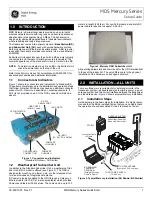
— 23 —
The default setting for this filter is
Disabled
. As may be
judged appropriate, however, you can turn the knob coun-
terclockwise for an HF cutoff of
11kHz
,
8kHz
,
6kHz
,
5kHz
3kHz
or
2kHz
. Before implementing this fixed HF rolloff to
reduce noise, you might first try the automatic stereo-to-
mono ‘blending’ option afforded in Menu Screen 6,
StMode:Blend-St
. This is a program-controlled function
that proportionally reduces stereo separation (and noise) as
reception conditions deteriorate.
The cutoff frequency shown in this menu is approximately
the –3dB point of the filter. The filter slope is not a
straight-line function, but becomes steeper as the frequency
increases.
IF Bandwidth Control
(Menu Screen 21)
In the default
Auto
set-
ting, receive bandwidth
is automatically adjusted
to progressively narrow-
er settings when signal
reception conditions degrade. The receiver pulls in the
band edges as either the high-frequency noise component of
the baseband signal increases, or as interference from an
adjacent-channel station encroaches.
You also may select bandwidth values manually. Push and
turn the knob counterclockwise to select:
110kHz
,
84kHz
,
60kHz
or
40kHz
. Unlike AM radio, you won’t hear the high
frequencies roll off as receiver bandwidth is reduced. In-
stead, stereo separation and harmonic distortion perfor-
mance will be compromised as the bandwidth narrows. If
the
Auto
setting is not effective in lessening ‘splatter’ from
an adjacent channel, try the lower cutoff values to reduce
the audible interference. When a setting is selected, push
the knob again to fix it in memory.
HIDDEN MENUS
The INOmini 673 also has settings for little-used, set-and-
forget functions. From most normal navigational menus,
push and hold-down the knob to access these top-secret
settings.
— 24 —
Firmware Version
(Hidden Menu Screen 1)
The
673 Firmware
screen will apprise you of what firm-
ware version is installed in your unit.
FM De-Emphasis and Region
(Hidden Menu Screen 2)
De-Emph:
displays the current setting for FM audio de-
emphasis.
75us
(75 microseconds) is the standard for the
Western Hemisphere, and
50us
for Europe and the rest of
the world. Push and turn the knob to change this selection.
Highlight and enter
Region
to load the proper list of pre-
defined RDS PTY classifications. Set this to
RBDS
for North
America or
RDS
for Europe and most of the rest of the
world. If you are operating outside of the US, Canada or the
European Union, consult the appropriate Radio Authority to
verify a proper choice.
Alarm Polarity
(Hidden Menu Screen 3)
When an alarm is triggered, the rear-panel ‘tally’ outputs
can take the form of either a closure to ground or a fulltime
ground that goes open-circuit for the alarm.
Push the knob and
R
(RDS Alarm) will begin
blinking. Turn the knob
to select
G
, a ground for
the alarm or
O
, an open
circuit from a normally-grounded condition. Push the knob
to save the setting, which will take you to a blinking
L
(Low
Signal). Make your selection, push the knob and do the
same for A (Audio Loss). Push the knob a final time to save
settings and release the menu.
In the example above, the rear-panel
R
and
L
terminals will
give closures to ground for their associated alarms, and the
A
terminal will be grounded and go open-circuit for Audio
Loss.
Backlight Color
(Hidden Menu Screen 4)
The INOmini 673 has a large, easy-to-read, backlit LCD dis-
play. An RDS Alarm, Low Signal or Audio Loss condition
will cause the display to flash the alarm notification against
a red background to further call attention to the matter.


































